Abstract
The surface antigens of cultured human malignant astrocytomas were analyzed by using mouse monoclonal antibodies. BALB/c mice were immunized repeatedly with either SK-MG-1 [a glial fibrillary acidic protein (GFA)-negative astrocytoma line] or SK-AO2 (a GFA-positive astrocytoma line). After fusion with NS/1 mouse myeloma cells, 12 antibody-producing clones were selected for detailed study. Serological analysis permitted the identification of nine distinct antigenic systems. Four monoclonal antibodies (Ab AJ225, Ab AO10, Ab AJ8, and Ab AO122) identified cell surface antigens preferentially expressed on tumors of neuroectodermal origin, and these antibodies subdivided the astrocytoma panel into distinguishable subsets. The determinant detected by Ab AO10 and Ab AJ8 showed mutually exclusive expression on the astrocytoma lines. The AO10 and AJ8 phenotypes appeared to reflect the differentiation state of the cultured cells; 4/7 AO10-positive astrocytomas expressed GFA, an intracellular astrocyte differentiation antigen, whereas all AJ8-positive astrocytoma (9/9) were GFA-negative. Five antibodies (Ab AJ10, Ab AJ9, Ab AJ17, Ab AJ425, and Ab AJ2) recognized determinants widely distributed on normal and malignant cells. Four antibodies defined in this study precipitated proteins from reduced preparations of radioisotope-labeled SK-MG-1 and SK-AO2 cells: Ab AJ225 (Mr 145,000); Ab AO122 (Mr265,000); Ab AJ10 (Mrs 195,000 and 165,000); and Ab AJ2 (Mrs 170,000, 140,000, 140,000, and 28,000).
Full text
PDF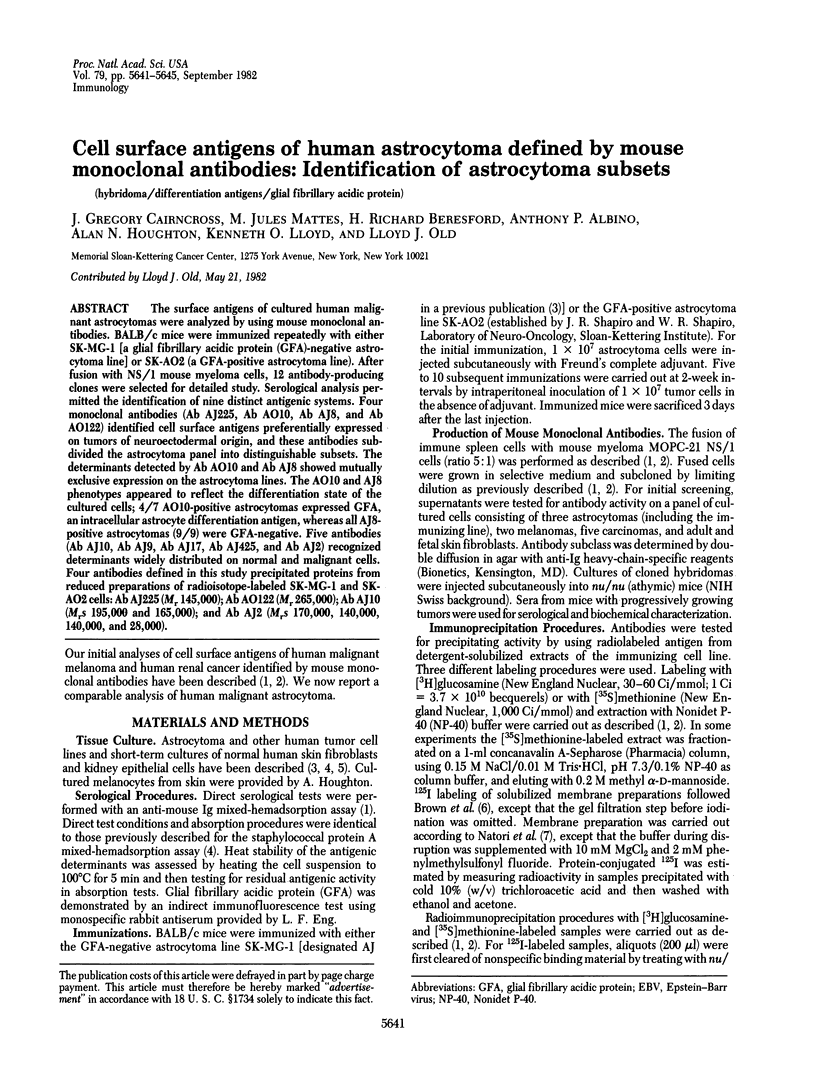
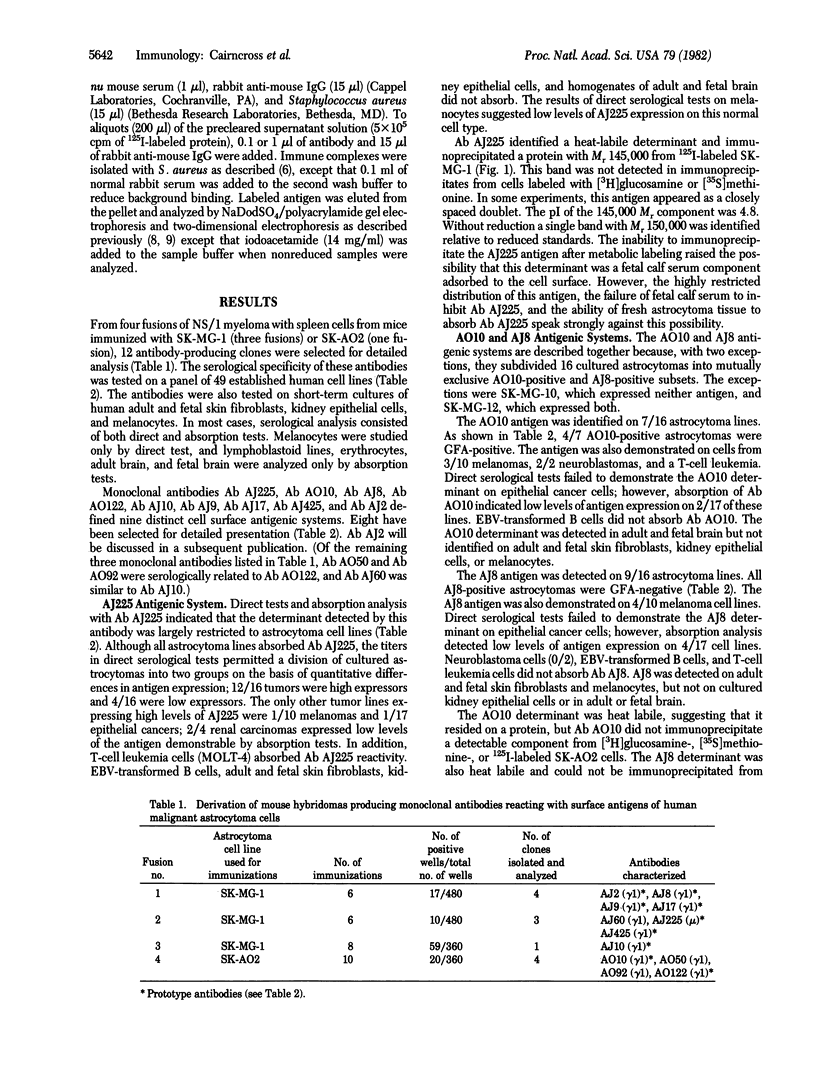
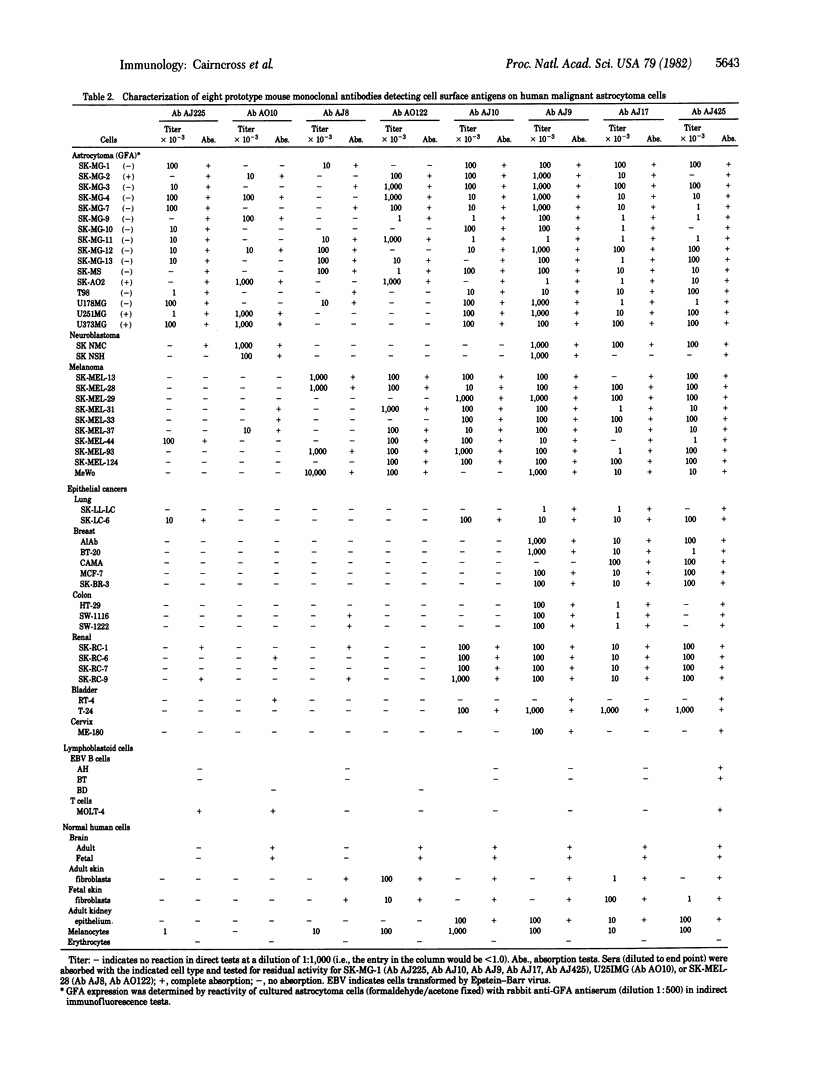
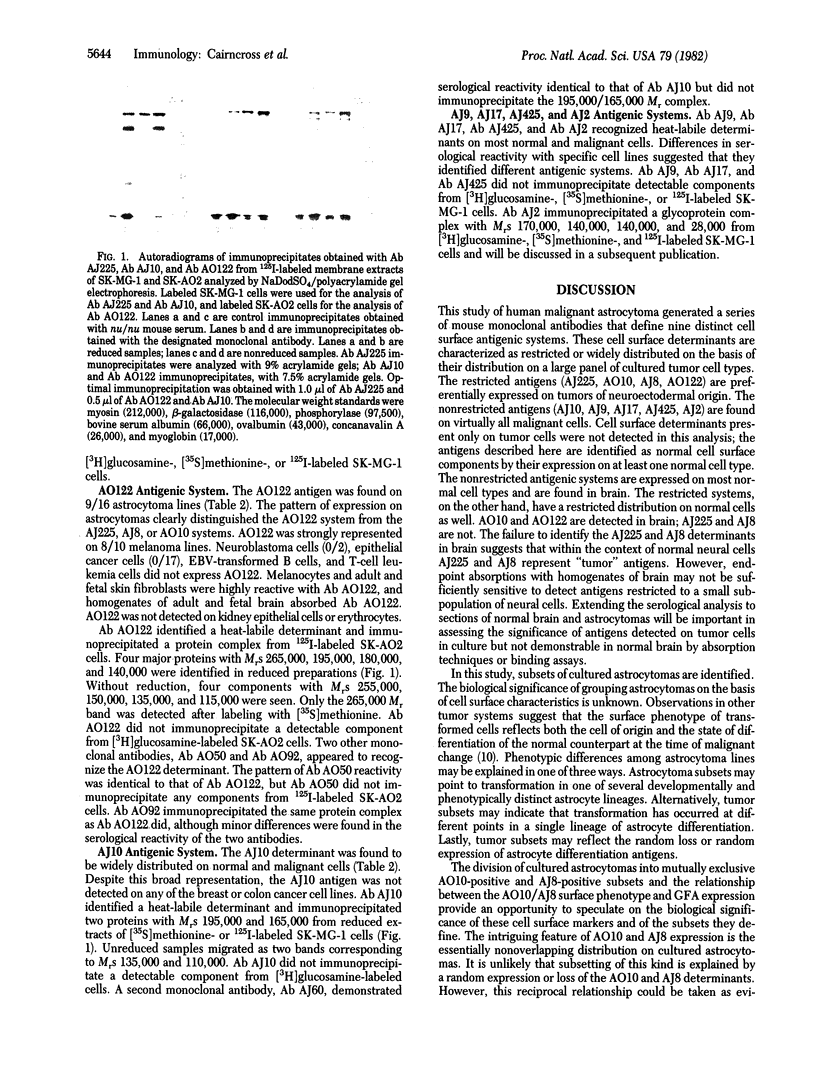
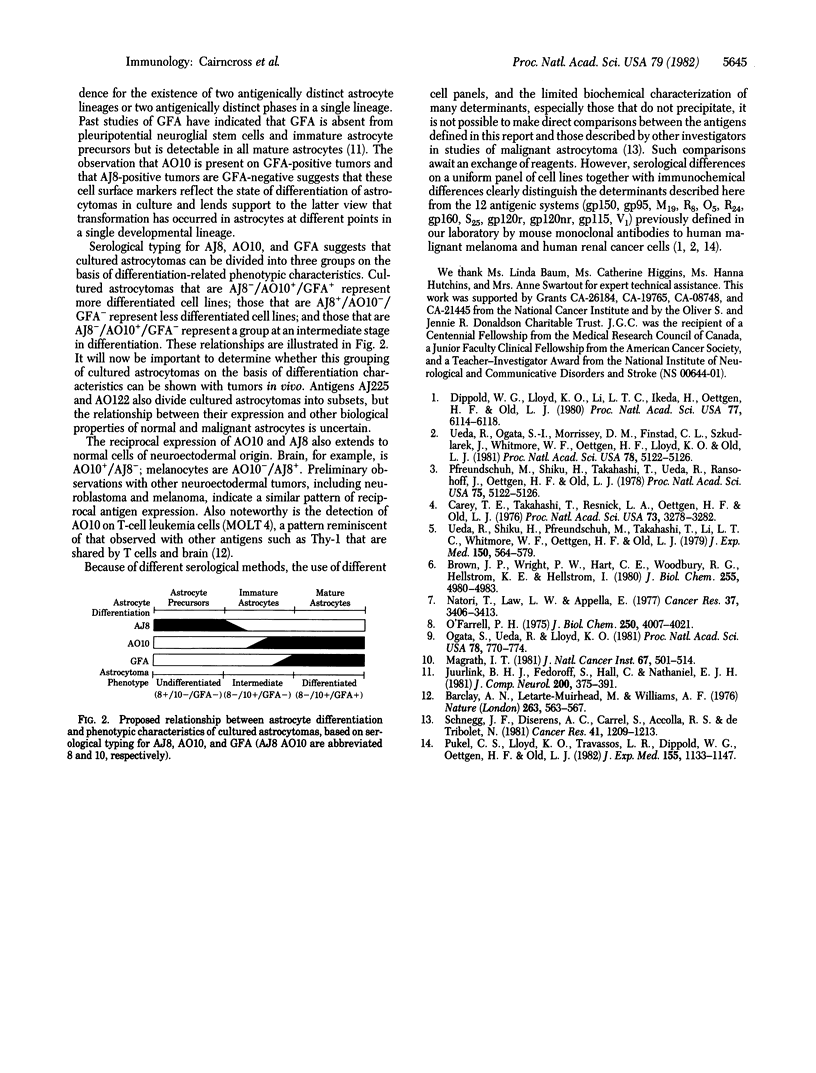
Images in this article
Selected References
These references are in PubMed. This may not be the complete list of references from this article.
- Barclay A. N., Letarte-Muirhead M., Williams A. F., Faulkes R. A. Chemical characterisation of the Thy-1 glycoproteins from the membranes of rat thymocytes and brain. Nature. 1976 Oct 14;263(5578):563–567. doi: 10.1038/263563a0. [DOI] [PubMed] [Google Scholar]
- Brown J. P., Wright P. W., Hart C. E., Woodbury R. G., Hellström K. E., Hellström I. Protein antigens of normal and malignant human cells identified by immunoprecipitation with monoclonal antibodies. J Biol Chem. 1980 Jun 10;255(11):4980–4983. [PubMed] [Google Scholar]
- Carey T. E., Takahashi T., Resnick L. A., Oettgen H. F., Old L. J. Cell surface antigens of human malignant melanoma: mixed hemadsorption assays for humoral immunity to cultured autologous melanoma cells. Proc Natl Acad Sci U S A. 1976 Sep;73(9):3278–3282. doi: 10.1073/pnas.73.9.3278. [DOI] [PMC free article] [PubMed] [Google Scholar]
- Dippold W. G., Lloyd K. O., Li L. T., Ikeda H., Oettgen H. F., Old L. J. Cell surface antigens of human malignant melanoma: definition of six antigenic systems with mouse monoclonal antibodies. Proc Natl Acad Sci U S A. 1980 Oct;77(10):6114–6118. doi: 10.1073/pnas.77.10.6114. [DOI] [PMC free article] [PubMed] [Google Scholar]
- Juurlink B. H., Fedoroff S., Hall C., Nathaniel E. J. Astrocyte cell lineage. I. Astrocyte progenitor cells in mouse neopallium. J Comp Neurol. 1981 Aug 10;200(3):375–391. doi: 10.1002/cne.902000307. [DOI] [PubMed] [Google Scholar]
- Magrath I. T. Lymphocyte differentiation: an essential basis for the comprehension of lymphoid neoplasia. J Natl Cancer Inst. 1981 Sep;67(3):501–514. [PubMed] [Google Scholar]
- Natori T., Law L. W., Appella E. Biological and biochemical properties of Nonidet P40-solubilized and partially purified tumor-specific antigens of the transplantation type from plasma membranes of a methylcholanthrene-induced sarcoma. Cancer Res. 1977 Sep;37(9):3406–3413. [PubMed] [Google Scholar]
- O'Farrell P. H. High resolution two-dimensional electrophoresis of proteins. J Biol Chem. 1975 May 25;250(10):4007–4021. [PMC free article] [PubMed] [Google Scholar]
- Ogata S., Ueda R., Lloyd K. O. Comparison of [3H]glucosamine-labeled glycoproteins from human renal cancer and normal kidney epithelial cell cultures by two-dimensional polyacrylamide gel electrophoresis. Proc Natl Acad Sci U S A. 1981 Feb;78(2):770–774. doi: 10.1073/pnas.78.2.770. [DOI] [PMC free article] [PubMed] [Google Scholar]
- Pfreundschuh M., Shiku H., Takahashi T., Ueda R., Ransohoff J., Oettgen H. F., Old L. J. Serological analysis of cell surface antigens of malignant human brain tumors. Proc Natl Acad Sci U S A. 1978 Oct;75(10):5122–5126. doi: 10.1073/pnas.75.10.5122. [DOI] [PMC free article] [PubMed] [Google Scholar]
- Pukel C. S., Lloyd K. O., Travassos L. R., Dippold W. G., Oettgen H. F., Old L. J. GD3, a prominent ganglioside of human melanoma. Detection and characterisation by mouse monoclonal antibody. J Exp Med. 1982 Apr 1;155(4):1133–1147. doi: 10.1084/jem.155.4.1133. [DOI] [PMC free article] [PubMed] [Google Scholar]
- Schnegg J. F., Diserens A. C., Carrel S., Accolla R. S., de Tribolet N. Human glioma-associated antigens detected by monoclonal antibodies. Cancer Res. 1981 Mar;41(3):1209–1213. [PubMed] [Google Scholar]
- Ueda R., Ogata S., Morrissey D. M., Finstad C. L., Szkudlarek J., Whitmore W. F., Oettgen H. F., Lloyd K. O., Old L. J. Cell surface antigens of human renal cancer defined by mouse monoclonal antibodies: identification of tissue-specific kidney glycoproteins. Proc Natl Acad Sci U S A. 1981 Aug;78(8):5122–5126. doi: 10.1073/pnas.78.8.5122. [DOI] [PMC free article] [PubMed] [Google Scholar]
- Ueda R., Shiku H., Pfreundschuh M., Takahashi T., Li L. T., Whitmore W. F., Oettgen H. F., Old L. J. Cell surface antigens of human renal cancer defined by autologous typing. J Exp Med. 1979 Sep 19;150(3):564–579. doi: 10.1084/jem.150.3.564. [DOI] [PMC free article] [PubMed] [Google Scholar]



